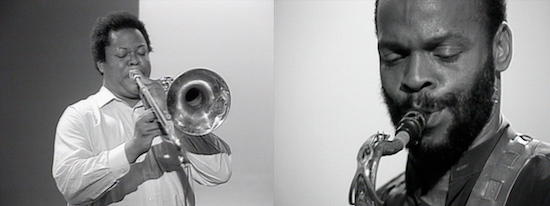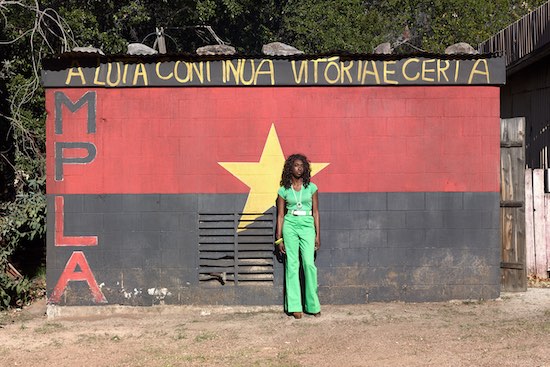Stan Douglas, A Luta Continua, 1974, 2012, Digital C-print mounted on aluminum, 120.7 x 181 cm. Courtesy of the artist, Victoria Miro and David Zwirner
What was the past like? The past that we cannot know because we weren’t around. How did it feel? The texture of time, in search of lost time; this is a central concern for Stan Douglas. He knows that some documentaries suffer an essential lack: actual footage of the past can at times compound the distance and render it untouchable. His photographic and video work aims for the kind of imaginative identification found in the best historical novels with their immediacy and punch. As Douglas himself says, “sometimes there’s more truth in the lie than in the documentary”.
Splicing Block is his first solo show in Berlin for eighteen years. There are three of his key works here. At first each seems straightforward but then, like walking on an icy pavement, things get slippy and somehow the ineffable past seems present, more felt.
Hors-champs (1992) is a video installation where a band plays Albert Ayler’s free jazz piece Spirits Rejoice (1965). George Lewis pumps his trombone with manic exuberance, Kent Carter is on bass, Oliver Johnson drums, and the über cool Douglas Ewart blows the saxophone. They play for about thirteen minutes and dip and dart between styles and moods that take in excerpts from La Marseillaise, the blues, and hints of gospel with its call and response phrasings. The playing is joyous, intermittently anarchic, and resolutely alive. Shot in black and white, the film deliberately triggers memories of footage from TV in the early 1960s, specifically the French show Modern Jazz at Studio Four.
The group improvises with consummate skill: their potent facility a deliberate gesture of intent. We recall this was a time of civil rights demonstrations, optimism for change even in the face of malignant reactionary forces; freedom was everything. Filmed in a basement studio at the Centre Pompidou in Paris Hors-champs is seen on two projections using both sides of a suspended screen. On one there is the performance as if televised: the minimal stage gives the show a clinically clean feel that seems miles from the hothouse atmosphere of the average club. On the other we see ‘off-air’ shots, what might otherwise have been discarded edits, that which is excluded or ‘out of field’, i.e. ‘hors-champs’.
This work, that title, hints at a subtle albeit powerful metaphor. We recall the exile of top Afro-American jazz players to Paris in the 1950s escaping the racist violence and inequalities of the Eisenhower era. Giants like Bud Powell, Dexter Gordon, Miles…

Stan Douglas, Hors-champs, 1992, two-channel video installation, 13’20’’, b/w, sound, dimensions variable. Video still. Courtesy of the artist, Victoria Miro and David Zwirner
Speaking of the man with the horn, Davis is the hidden presence haunting Luanda-Kinshasa (2013), a six-hour video that sees ten musicians jamming. The session recreates and brilliantly mimics the style of Miles’ Olympian sequence of early 1970s albums. Douglas has said that On the Corner (1972) is his favourite recording of all time; for him “this is what utopia sounds like”. Don’t argue.
The musicians in Luanda-Kinshasa are playing but also, in a sense, acting. They did not actually play all together the whole six hours. Douglas shows his skills at mixing and cutting with that splicing block of the show’s title. These rival those of Miles’ producer, Teo Macero, in creating a seamless symphony of funk and disco, jazz and Afrobeat. This then is a twin composition of sound and vision and all the more impressive for that.
The fiction is made even more convincing by the fact that Luanda-Kinshasa was filmed in a set designed to look like the Columbia studios in New York where Davis recorded. There’s a creeping sense of déjà vu with Douglas deliberately nodding to Jean-Luc Godard’s film about the Rolling Stones, Sympathy for the Devil (1968), by using similar studio partitions to separate the musicians and a colour scheme of dull oranges, pale yellows and scuffed browns. These immediately conjure up a lost world of floppy fedoras, dope-busts, and Oz magazine: a time when people really did look into Jagger’s eyes and scored. The musician-actors are dressed variously in psychedelic paisley tops, bandanas, turtleneck sweaters; Afros and beards also feature prominently. The gear is echt too – a tatty Fender Rhodes, battered tablas. We see studio boffins dressed like CIA operatives, engineers in grey-blue overalls. You can almost hear Mojo types saying in reminiscence, you had to be there. Well, Stan Douglas takes you there.
Why Luanda-Kinshasa as a title? We recall that this was the era of Ali-Frazier, the Rumble in the Jungle, Black Power salutes at the Mexico City Olympics, Get Up With It, and the twin poles of the post-colonial legacy: optimism and despair in Africa.
Which brings us to the Disco Angola. Here Douglas imagines himself as fictional photojournalist shuttling between Africa and New York City and stages a series of photographs in California, again faking a history. Several large-format photographs from this series are part of Splicing Block. They look like elaborate film stills and we learn that their set-up is just as involved as making a movie. Douglas is from Vancouver and this aspect of his work chimes with similar fictional constructions by other key artists from the city like Jeff Wall and Rodney Graham. Douglas calls these “costume dramas in fragments”.
The Angolan scenes show checkpoints, exhausted Portuguese sitting on their suitcases, packed and ready to head home. The New York episodes are from the dance floor and depict the early excesses of disco. We note odd linkages between the coat check of a nightclub and armed guards in the bush, the weary colonialists waiting transport home and enervated revelers staring at the bacchanalia. Douglas is skilled at drawing parallels between what at first seem disparate concerns.
Then we hear more music, this time disco, and see a group of album covers on a table – more Miles, Hamilton Bohannon, Herbie Hancock, and Charanga ’76. The latter had a hit with ‘No nos Pararan’, a title that chimes with the Portuguese slogan A Luta Continua – ‘The Struggle Continues’. This was the motto of the MPLA, the Angolan liberation movement and we see this spray-painted on a wall in another photograph. You’ll know the tune better as Ain’t No Stoppin’ Us Now.
Splicing Block is easily the grooviest and most optimistic show I’ve seen this most tiresome and duplicitous of years. And what with Trump’s impeachment hotting up maybe there’s some hope after all. We’re on the move.
Stan Douglas: Splicing Block is at the Julia Stoschek Collection, Berlin, until 1 March 2020


